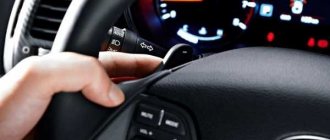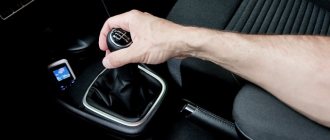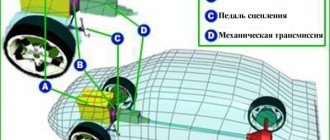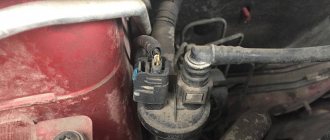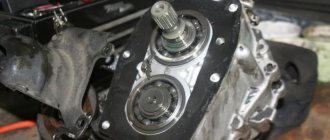Traveling by car does not always go smoothly. What to do if the car jerks when changing gears? What caused it? Drivers themselves name two main reasons for this behavior of vehicles.
The first is a “cold start”, the car’s engine did not have time to warm up from the moment it was started until it started driving, which is typical at low temperatures in winter.
The second reason why the car began to twitch is the driver’s inability to properly operate the manual transmission. A manual transmission requires certain skills; if a driver has only used an automatic transmission, then he is unlikely to use a manual transmission and drive with ease. There is not enough knowledge here that when engaging reverse gear you need to turn the lever “here”.
Manual transmission jerks when shifting
In the case of mechanics, twitching most often occurs when the engine is not warmed up. This should not be considered a defect, but you should try to avoid driving in such modes.
The manual transmission is simple in design and is unlikely to provoke jerks when transmitting torque from the engine to the drive wheels. But it may suffer from engine and clutch malfunctions.
Jerks when shifting gears create shock loads on gears, couplings, shafts, and gearbox bearings. Chips and other damage to these expensive and difficult to repair transmission parts are possible. Often, jerking is caused by wear of the clutch mechanism, which, when used in the city or, conversely, on very rough rural roads, experiences excessive loads.
For a competent driver, a working clutch will not “pull” the gearbox, but a worn-out clutch, and even with an inexperienced “driver,” can quickly cause damage.
Jerking is possible due to the following driver errors when controlling the gearbox and clutch:
- Squeezing and releasing the clutch pedal with the moment of gear shifting is incorrectly coordinated;
- switching at too high engine speeds;
- shock pressing of the gas pedal after changing gear;
- driving in a gear that is too high for a given speed, when the tachometer is less than 1200–1500 rpm, and trying to accelerate from that speed in the same gear.
Why is this phenomenon harmful to the car?
Jerking when changing from one gear to another or while driving the car equally negatively affects the technical condition of the engine and transmission mechanisms. The shock loads that arise in this case have a detrimental effect on gears, bearings, switching mechanisms and other parts. As a result, chips and cracks of gear teeth and bearing destruction may occur. After this, the car may remain idle for a long period.
Almost everyone immediately has a question about what is happening to the car, what to do, how to avoid such phenomena? First of all, you need to understand the source of this problem. It can be located not only in the power unit, but also in gearboxes. This does not depend at all on the design; it can be mechanical or automatic. In this article we will try to consider all possible cases of such unpleasant phenomena.
Impact of jerks on the car
Communities VAZ Repair and Modification Blog VAZ 21124 engine troubles, stalls, jerks when sharply pressing the gas pedal problem solution
Whether jerking the car is beneficial or harmful is a rhetorical question. It’s the same as poking a person with a knife and asking if your health is improving. Any kind of jerking of the car is harmful, be it just a jolt when driving or a consequence of changing gears.
The main impact falls on the transmission unit and the engine part. First of all, the load on moving elements (bearings, switches, gears) increases. Each impact can deform, leave a crack or completely break any of these elements. Repairs can take a long time and cost the car owner a significant amount of money.
That is why it is important to initially determine the reason why the car began to twitch and eradicate it
At high speeds
But the jerking of the car at high speeds is more related to the ignition system.
In a normally operating engine, the ignition system automatically adjusts to certain conditions by changing the ignition timing.
That is, when necessary, the ignition becomes either a little early or late.
A malfunction in the automatic ignition will cause twitching.
Do not forget that the cause of uneven movement will be not only a malfunction of the system, but also the failure of one of its elements.
And these are only the reasons that can arise with the engine, without affecting the transmission.
You need to immediately narrow the search for identifying the reasons for the car twitching to two engine systems - fuel and ignition, but you should not discount the transmission.
The car jerks when accelerating
VAZ 2112 16 valves twitches during acceleration costs 4th generation LPG
Do you pick up speed and the car starts to jerk, its ride stops being smooth? The reason lies in the inconsistent supply of fuel to the float chamber: it disappears from there faster than it enters. The fuel pump supplies fuel there, so the problem may be that it is faulty.
How to “cure” him? To do this, remove the fuel pump cover and carefully inspect the hole where the valve should be located. Often the O-ring lies nearby, not in place, or is missing altogether. Due to depressurization, interruptions in fuel injection occur, and, consequently, the car jerks while driving.
Repair in this case consists of replacing the valve and restoring the tightness of the system. You can do it yourself if you have a new O-ring of suitable diameter and tools. This work will take at most half an hour, but a professional can do it in 5 minutes.
What can you say about automatic transmission?
Automatic transmission is considered to be the most important and most complex mechanism of a modern car. Therefore, this unit should be given the greatest attention and regular and high-quality maintenance should be carried out. If this is not done, then it may happen that a small breakdown can turn into big problems.
Jerking in cars with automatic transmission can also occur for several reasons. Let's look at them:
- Low ambient temperatures. Such problems occur mainly in the cold season. The box should be warmed up gradually and such problems will disappear after some time;
- Use oil for longer periods than recommended in the machine's operating instructions. It is especially dangerous to use such oil in winter. It is necessary to replace it in a timely manner, otherwise “costly” problems with the automatic transmission will arise;
- Insufficient oil level in the box also contributes to jerking when driving.
For more information about this problem, read the article “What to do if the automatic transmission kicks and jerks when shifting.”
Some drivers may notice that these are not all the reasons for this phenomenon. We must agree with this, since every year there are some improvements and changes to the components and assemblies of the machine. We tried to consider the possible reasons why the car jerks when changing gears. This story should encourage drivers to correctly identify and fix such problems with their car.
In absolutely any car, such a problem can arise when the car starts to jerk when changing gears. Often the problem is most noticeable on a cold engine, as well as in first gear. But you shouldn’t immediately blame the box; let all the main suspicions immediately fall on it. The system of the technical part of the car is quite complex, so problems here may not be related to visual and sound perception. It is necessary to check the entire car for possible problems, and we will describe the most active suspected failures below in the publication.
If your car is jerky when changing gears from the very beginning, it's worth paying attention to your driving style. Modern cars have an adaptive on-board computer system that controls the operation of each unit. Perhaps you should change your driving style. If the jerking occurs automatically, then in 99% of cases it is the gearbox that is to blame, and you will not be able to carry out any repair work yourself in the garage - you need to give the car to specialists.
Why does the car jerk while driving?
Power system malfunctions
Choosing oil for manual and automatic transmissions of Lada Vesta
So, why does the car jerk at low speeds when driving? The first thing the most experienced motorist will say is that you need to look for a problem in the fuel system. And he will be right. When the car starts moving, the cylinders may not receive enough air-fuel mixture, which leads to improper operation of the transmission due to lack of power. If an uneven amount of fuel-air mixture enters the “heart” of the car, then the fuel will simply ignite poorly, which is why the explosion stage of the mixture is disrupted; all these processes lead to incorrect operation of the engine, which the driver can feel and experience discomfort while driving.
Measures to identify and eliminate the causes of vehicle jerking related to the fuel system:
- Test the performance of the hall sensor;
- Check the throttle position;
- Check the condition of the fuel injection nozzles.
It is advisable to check the condition of all elements of the fuel system and this applies to all types of engines. Experts also claim that depressurization of the pipes leads to the fact that the engine begins to “starve”, in other words, this leads to fuel “starvation” of the engine. As a result, the driver, while driving the vehicle, will feel “dips” in the operation of the engine. Therefore, the pipes should be carefully checked, and if there are any malfunctions, they should be repaired immediately.
Ignition system failure
If the fuel system has been thoroughly checked and no faults were found, then you should proceed to diagnosing the ignition. Owners of cars with an injector often ask the question: “Why does the car jerk at low speeds?” And for good reason, because the operation of the fuel system of a power unit with an injector can be disrupted due to improper operation of any sensor. A common cause may be low voltage that does not ignite the fuel mixture.
At this stage of diagnosis it is necessary:
- The first step is to check the ignition coil;
- Check the condition of the spark plugs;
- Test high-voltage wires and distributor;
- Check the condition of the camshaft and crankshaft position sensors.
Often, the car jerking when driving is due to the fact that the spark plugs have lost their functionality. This is the most harmless breakdown. If the reason lies in a malfunction of the camshaft position sensor, then in this case it will not be possible to start the engine at all. And here you can’t do without qualified help.
Problematic gearbox
If a car with an automatic transmission suddenly begins to twitch when driving at low speeds, then in this case it is worth reviewing the procedure for servicing the automatic transmission. Even a good transmission can malfunction and cause the vehicle to jerk if there is too much or too much transmission oil. The oil will simply foam, which will lead to the machine twitching.
If you notice that your car has begun to behave strangely, namely that at low speeds there are “dips” in the engine’s operation, jerking - these are the first signs that there is a problem lurking in one of the car’s systems that requires an immediate solution. Often you can solve the problem yourself, but there are times when you cannot do without the help of qualified specialists. You should monitor the quality of gasoline; fuel that is not of the highest quality sometimes causes a lot of trouble, and often causes the car to jerk.
Let's sum it up
Always start looking for possible problems among the most easily corrected points. For example, it is better to immediately check the settings of the on-board computer and its serviceability, and only then think about other possible problems. Also look at spark plugs and high-voltage wires - they are often the culprits of unexpected problems with the car's behavior.
You also need to remember about high-quality regular car maintenance. If the transmission or engine is not properly maintained, it will be extremely difficult to identify problems in the future. Fill the gearbox with high-quality oil and carry out other routine maintenance. If you have anything to add from your own experience, be sure to share the information in the comments.
“Non-standard” reasons for automatic transmission jolts
In addition to the reasons described above, the behavior of the automatic transmission can also be influenced by some “non-standard” reasons. For example, many car owners may mistake shocks that occur due to the “adaptiveness” of the box as a malfunction. Most modern automatic transmissions are able to adapt to the driver's driving style - shift gears depending on his actions on the road.
If the driver, for example, drives the last few kilometers quickly - brakes sharply and accelerates sharply - then the automatic transmission, “adjusting” to his driving, tries to engage gears “in the red zone of the tachometer,” allowing the full engine power to be used.
Vibration and jerking when reversing
There are situations when the car jerks while moving in reverse, and vibrations are also possible.
Here you need to consider which gearbox is installed.
If your car has an automatic transmission, you need to pay attention to the position of the engine protector.
It is possible that this element of the car was installed incorrectly when filling oil or performing other work. In this case, the exhaust pipe is close to the protection.
When you engage reverse, the engine tilts slightly, which causes vibration.
It is also necessary to pay attention that there are no touches along the entire perimeter.
If necessary, thick rubber seals must be installed.
There are also other possible reasons that are relevant for all cars:
- Nedogazovka. It is necessary to take into account that the reverse speed is higher than the first, therefore, at low speeds (about 800-1200 rpm), twitching may appear, and the car itself does not have enough strength to accelerate. Almost the same principle applies here as with the second speed.
- Poor contact. When moving backwards, the engine tilts a little. If there is a poor connection in the wiring, the situation gets worse when the reverse gear is engaged.
- Suspension. Even in ideal condition, this component gives a certain vibration.
- Severe wear on the differential.
- Low-quality CV joints or “shifters”.
- A worn clutch or some kind of defect if we are talking about a new car. More precisely, the basket presses the disc unevenly onto the flywheel.
- Wedging in the basket.
- Problems in the gearbox, namely the reverse gear.
Much depends on the car model. To determine a more precise cause, it may be necessary to check each of the presented versions. But it is better to contact experienced service station employees.
